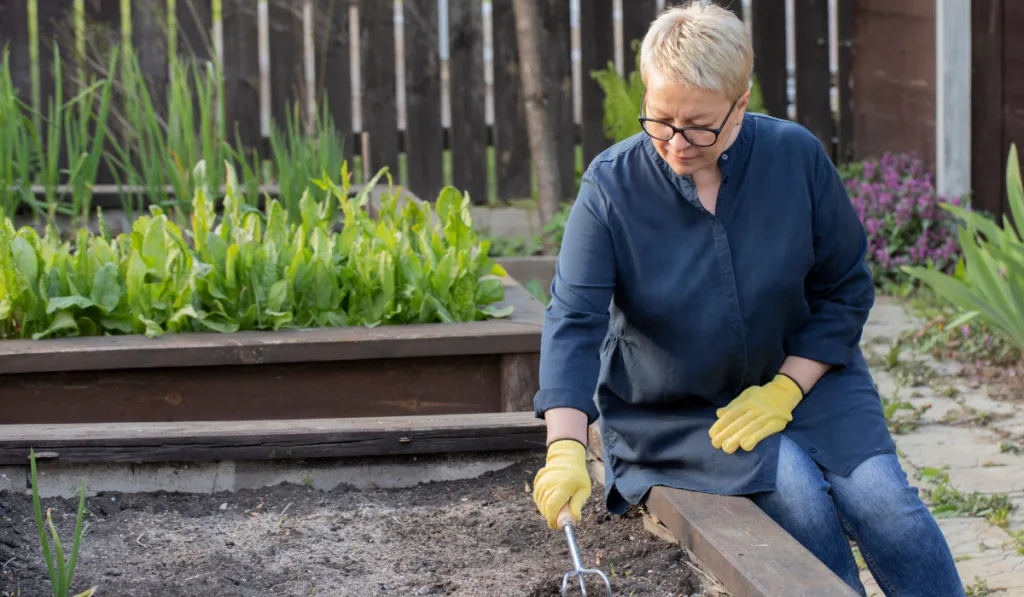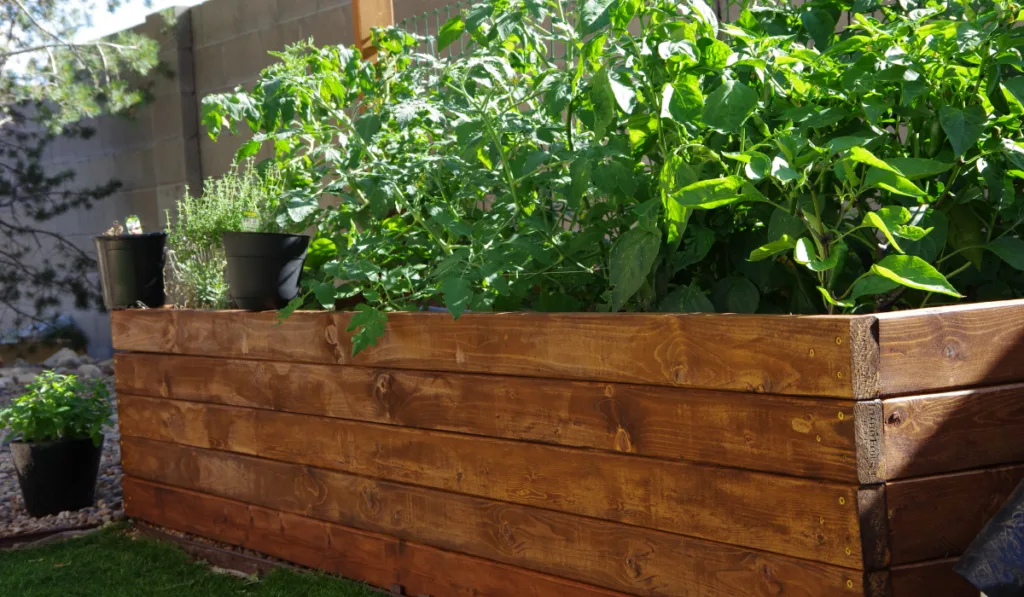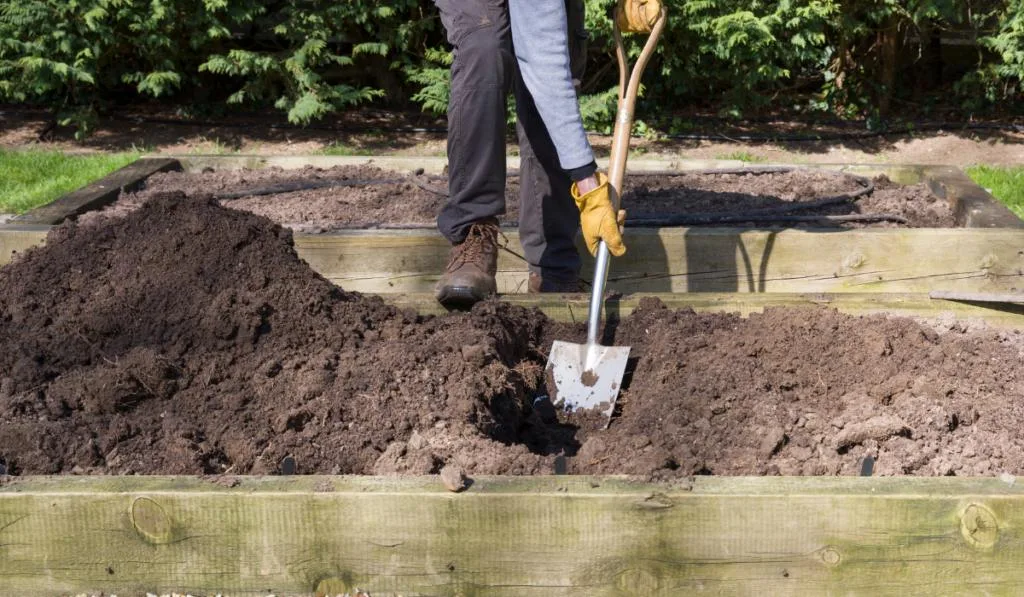Spring is the best season for gardening. After an idle winter, you get to resume your activities in the garden. But gardening in spring requires you to do some preparation since it is a new year of cultivation.
There are many things you can do to prepare your raised garden bed for spring planting. For example, you can turn in or uproot cover crops, check for and fix holes and cracks, install new or repair old trellises, etc.

Table of Contents
How to Prepare Raised Garden Beds for Spring Planting
Here are some ways to prepare your raised garden bed for spring planting:
1. Check for Leakage or Rotting in the Frame
Leakages are either cracks or holes. Water and nutrients can leach quickly if there is any leakage in the raised garden bed frame. If you find any leakage, you need to fix it immediately (before you start planting).
It is common for wooden raised garden bed frames (especially untreated ones) to rot. Rotting or decaying can be caused by the presence of microbes, moisture, high temperature, etc.
To prevent the wood rot from spreading in the raised bed, you need to remove the region of the wood where there is rot and replace it with treated wood.
Do not plant in your raised bed when you have not fixed leakages and rotting.
2. Buy New or Repair Old Gardening Tools
It is a new year of cultivation, so you need to put your tools in order.
Check your shovels, hoes, wheelbarrow, etc. to make sure that they are okay and can last till the end of the production cycle. If need be, replace old tools.
3. Remove Weeds and Fresh Mulch
It is common for cold-tolerant weeds to grow in your raised bed before spring. Before planting, make sure to remove the weeds. If you planted cover crops before winter, you should remove them if they are still fresh.
If the cover crops have died and have started to decay, however, you should turn them into the soil. Use weeds, fresh mulch, and cover crops to make compost that you will use later in the year.

4. Prepare the Garden Soil
Soil is very important in gardening. One thing about winter is that it compacts soil and makes it unsuitable for rapid root growth. To help prepare the soil for spring, use the tips below:
- Till and Turn the Soil: When you turn the soil, you loosen it and also help to aerate it. Turning soil helps plant roots to spread farther and more quickly.
- Mix Decaying Cover Crops into the Soil: Cover crops such as clover and alfalfa will enrich the soil with nitrogen and other nutrients. Do not turn over fresh cover crops as they will decompose slowly.
- Add Soil Amendments: If your soil is lacking certain qualities or nutrients, it is best to apply soil amendment before you start planting. Soil amendments are different types of products that help boost soil quality.
- Remove Pests: Some pests can damage your crops in the raised bed. If you do not remove some invertebrate pests, your seedlings can die in less than a week after planting. When turning the soil, check for pests and remove them.
- Add Soil (Optional): If you feel that you need more soil in the raised garden bed, now (i.e. before spring) is the best time to add more soil.
Remember that soil health is important, so you need the best quality of soil in your raised garden bed.
5. Start Your Plants Indoors
You can start your plant 2-3 weeks before springtime. The temperature indoors is warmer than that outside, so your seedlings can thrive indoors until the temperature outside is favorable.
You can start your plants near the window, but if it is too cold, start them in a warm place and use grow lights.
6. Install or Repair Trellises
If you are growing climbing plants, you should repair your torn trellis or install a new one.
It is best practice to install the trellis before you introduce your plants into the raised garden bed, but you can also wait till the plants are ready to climb before you do so.

7. Divide Perennial Plants (Optional)
If you have perennial plants in your raised bed, you should divide them. Perennial plants tend to grow in a cluster and that slows their growth because there will be high competition for nutrients in each cluster.
Separating or diving perennials helps them to grow quickly; so you can separate them if you wish.
8. Introduce Earthworms Back into the Raised Garden Bed
Earthworms are your friends. You should introduce earthworms back into the raised bed because they will make gardening easier for you. Here are some benefits of earthworms:
- Aeration of Soil: As earthworms move across the soil, they help aerate it. They dig mini holes through which they pass. The movement of earthworms allows plant roots to grow rapidly and have access to oxygen.
- Breaking Down of Organic Matter: Even though earthworms are not actual decomposers, they help the process of decomposition in their way. Earthworms eat dead materials and excrete waste that is easier for decomposers such as fungi and bacteria to act on.
- Depositing Castings into the Soil: The excretory waste of earthworms is very rich in nitrogen and other nutrients. Earthworm casting also helps boost the health of your plants.
As you can see, earthworms are your friends and you should introduce them to your raised garden bed.

9. Get Your Mulch Ready
Do not wait for your plants to be transplanted into the garden bed before you get your mulch. Prepare your mulch beforehand so that when you transplant your seedlings into the bed, you apply the mulch.
Mulch helps to:
- Prevent weed growth
- Prevent water loss by evaporation
- Give extra nutrients to plants
Do not forget to mulch.
Related Questions and Answers
1. When is the Best Time to Transplant Seedlings (Started Indoors) into the Raised Garden Bed?
You should wait until 5-7 days before spring fully arrives to transplant the seedlings into the raised bed. This will ensure that they do not die or grow poorly because of low temperatures.
If your raised bed is high enough and you feel that the soil temperature in the raised bed is suitable for your plants, you can transplant them into the raised bed.
2. How Often Should You Water Crops That You Grow in Raised Garden Bed?
Raised garden beds lose water quickly because the soil is elevated above the ground. You should water your raised bed plants 2-3 times daily and never allow the soil to be dry before you water again. To prevent constant water loss, you can install liners in your raised garden beds.
Note that with liners, you will need to water less regularly to prevent the soil from becoming too damp for plant growth.
When watering raised beds, consider the water need of your plants.
3. Can You Use Fresh Manure in Raised Garden Beds?
You should only use fresh manure in raised garden beds 4-5 weeks before planting. If you use fresh manure in a raised bed with plants in it, the manure will burn the crops.
Fermentation of the fresh manure can produce a lot of heat which can burn plants. Aside from heat, fresh manure releases a lot of nutrients faster than the rate at which your plants can absorb them. This makes the nutrients too much and can make plants lose a lot of water (because of osmosis).
You should only use rotted manure when you have planted in the raised garden bed already. To use fresh manure, apply it 4-5 weeks before planting.

4. What are the Advantages of Raised Garden Beds over Traditional Gardening in Spring?
Raised garden beds have elevated soil, so the temperature of the soil in a raised bed is different from that of the soil in the ground. This means that raised bed can be more suitable for planting in early spring than normal garden soil.
Other advantages of raised garden beds over traditional gardening are:
- Easily Planned Square Foot Garden: Square foot gardening is a method of gardening in which you separate your bed into various partitions that have a length and width of 1 foot each. Square foot gardening helps gardeners to maximize the amount of space used.
- Prevention of Pests and Weeds: Gardeners have better access to raised garden beds, so you can easily find and uproot weeds. If you install a horizontal liner in your raised bed, you can prevent pests from entering the soil from below.
- You Can Grow Plants Anywhere: You do not have to worry about soil quality. With raised beds, you can grow your vegetables anywhere by bringing in new soil.
5. What Should You Plant in Raised Garden Beds?
You can plant just about anything you like in raised garden beds.
You can plant annuals, perennials, root vegetables, leafy greens, shrubs, dwarf trees, etc. Raised garden beds are suitable for many types of plants.
Final Thoughts
You should put your raised garden bed in order before spring so that gardening will not stress you when it is time to grow your plants.
There are different ways to prepare your raised garden bed for spring.
For example, you need to turn the soil, remove fresh weeds, introduce earthworms, remove pests, check for and fix leakages and rots, etc. Happy gardening!
